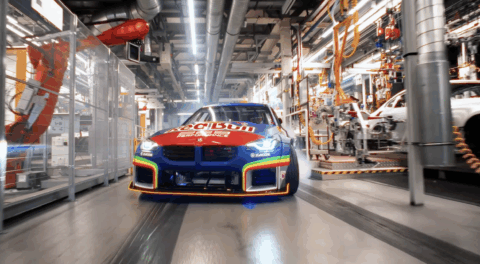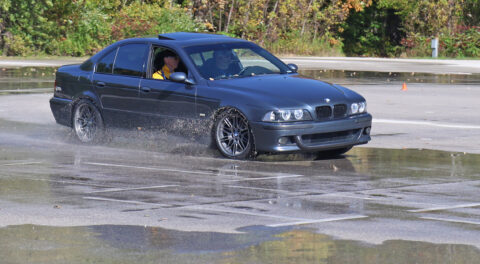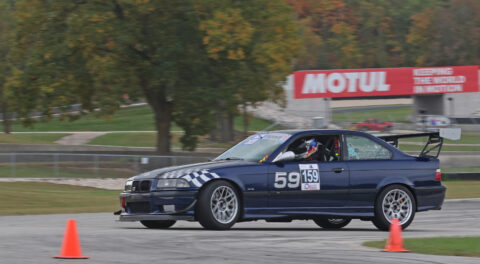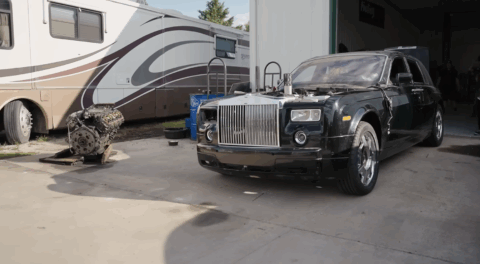It was a week for dealing with car sales, both my own and others. As I wrote about two weeks ago, I’m helping Mike Miller’s fiancée and beneficiary Lisa Binder sell his 1977 BMW 320i. She detailed and photographed the car, and I submitted it to Bring a Trailer. It hasn’t been accepted yet, so if anyone wants to offer Lisa $30k for it, the window of opportunity is rapidly closing.

Mike’s car still looks a-vahry nahce.
But the big news is that the Bavaria is going to about the best home I can imagine. As I wrote last week, Jim and Susan Strickland, friends from Alabama who’ve bought two other cars from me—”The Lama” (my 1985 535i) and “Kugel” my long-time ’72 2002tii—said they were interested in the car. I had just re-photographed it in the sun in preparation for submitting it to BaT, and although I don’t think of Sahara as a color that’s capable of popping, it totally did, as did the Tobacco interior. That was enough to shove the Stricklands over the edge and talk with me seriously about buying it.
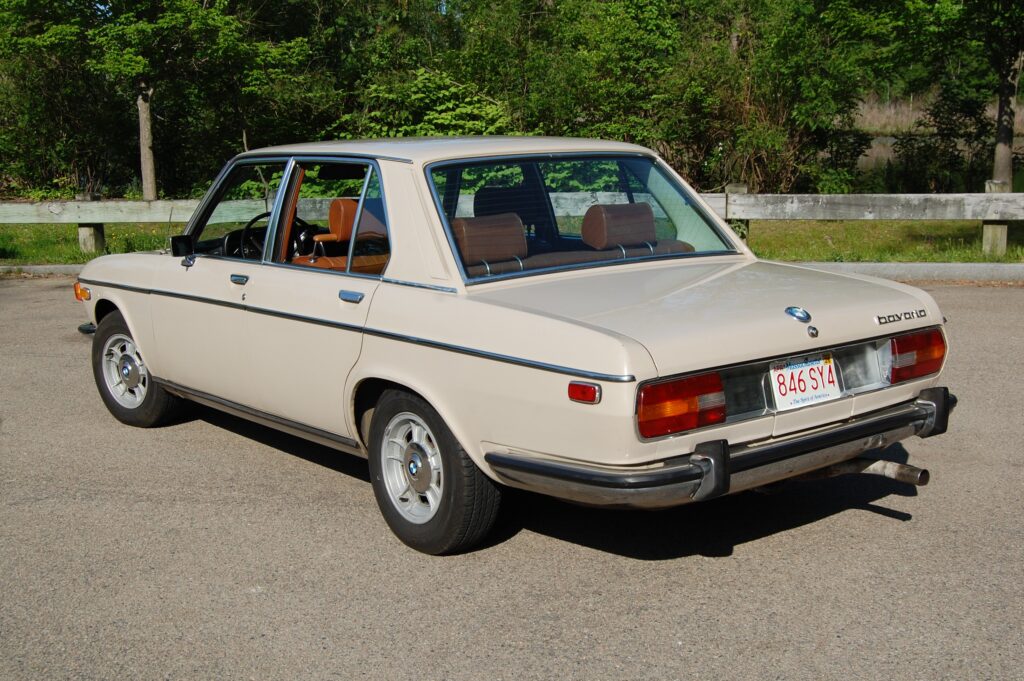
Who knew that Sahara could pop?
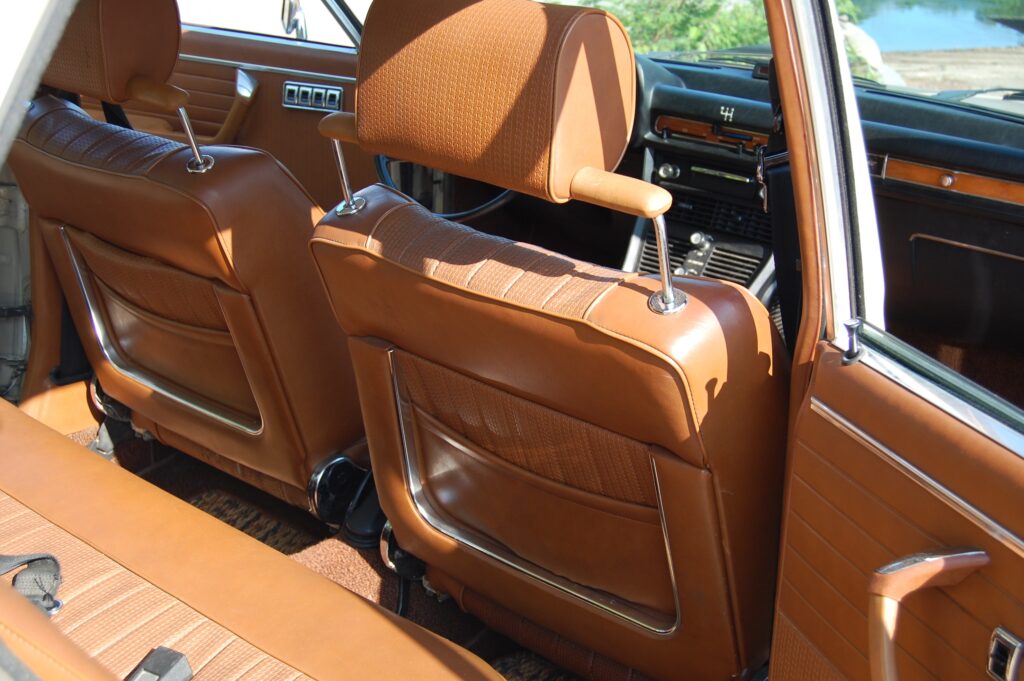
I usually don’t photograph interiors in the sun due to the inevitable shadow, but man this totally worked.
As is my way when I sell cars to friends, I looked at recent Bavaria sales on Bring a Trailer, was brutally honest with myself about where mine fell in the pantheon of condition, priced it at the low end of what I thought it would bring, and promised to fix a few of the things that would be on my punch list if the car went on BaT (it’s always better to pull something off the needed-work list than to apologize for it). These included changing the oil, replacing the rotted muffler that I’d wrapped in chimney pipe 11 years ago with the new-old-stock one that’s been sitting in my garage for five years, getting the hood to stay up without the need for a broomstick, and dealing with the car’s annoying even-throttle buffeting.
I put the car up on my mid-rise lift and drained the oil, then went into the garage closet to pull out one of the four Mann H1038 oil filters I’d somehow accumulated for the canister-style housing on the engine that’s no longer in my ’73 3.0CSi. I simply assumed that the Bavaria used the same filter. To my surprise, it didn’t—it needed a smaller OX41D filter instead. D’oh! I dashed upstairs to the laptop and put one on order from FCPEuro in nearby CT, which got it here in two days.
But while I was under the car came a bigger surprise—the boot on the clutch slave cylinder was ripped. Damn, I thought, I wish I’d seen that earlier so I could’ve put a new clutch slave on the same order.

Yuck.
No matter. Back upstairs to the laptop, check RealOEM for the part number, search for it on FCP, and… holy crap, $330 for the genuine OE part? Searching eBay for the OEM ATE part showed some domestic vendors selling them in the $240-$300 range. I noticed that one of them was the old Roundel advertiser BimmerParts (Zygmunt Motors). I called them up, we had a good laugh that I hadn’t ordered anything from them for 30 years because the now-defunct Bavauto was just up the road from me in NH and I now mostly use FCP, and the guy said “Tell you what… $220 shipped.” Never underestimate the value of doing the human-to-human thing.
While I was waiting for it to arrive, I removed the old slave. Because this is a steel cylinder that lives in a hole in an aluminum bell housing, sometimes corrosion of dissimilar metals basically corrosion-welds it in place, requiring copious quantities of heat and twisting with a pipe wrench to get it out. Fortunately, this wasn’t the case. However, even when they’re not stuck, they’re a little tricky to deal with. First you need to remove the half-moon-shaped flywheel cover and the bracket that holds it in place in preparation to draw the slave forward. There are circlips (snap rings) on both sides of the slave. What you need to do is undo the springy clip on the boot and the rear-facing circlip, and slide the body of the slave forward, leaving the push-rod, boot, and both clips hanging in space. You then withdraw these by sliding them forward into the hole in the bell housing, and then out.
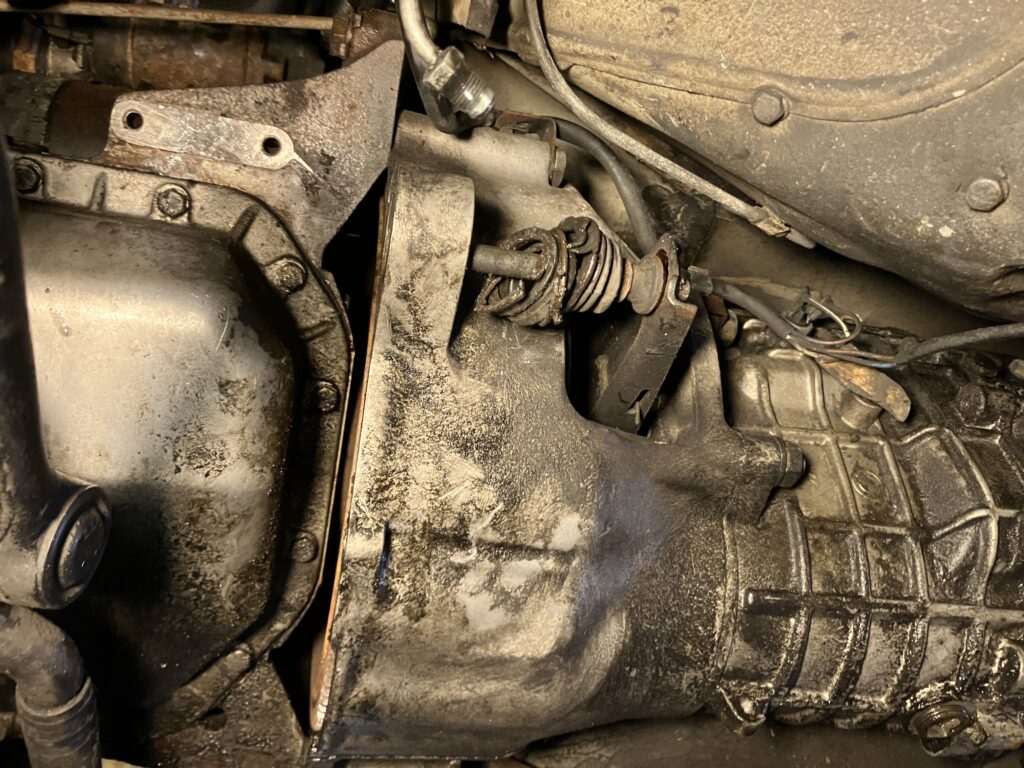
The view with the slave withdrawn from the front and the push-rod, rubber boot, and clips dangling.
To get the new part in, you do the same thing in reverse, making sure the rear-facing circlip is staged to be placed into position. Doing so is awkward, as you need to have one hand on the snap-ring pliers (which themselves are balanced with their prongs in the holes in the circlip, which isn’t easy since the clip is just hanging in space on the push-rod) while you shove the cylinder rearward into the hole, pushing against the tension on the internal spring while delicately maneuvering the circlip into position in its slot.
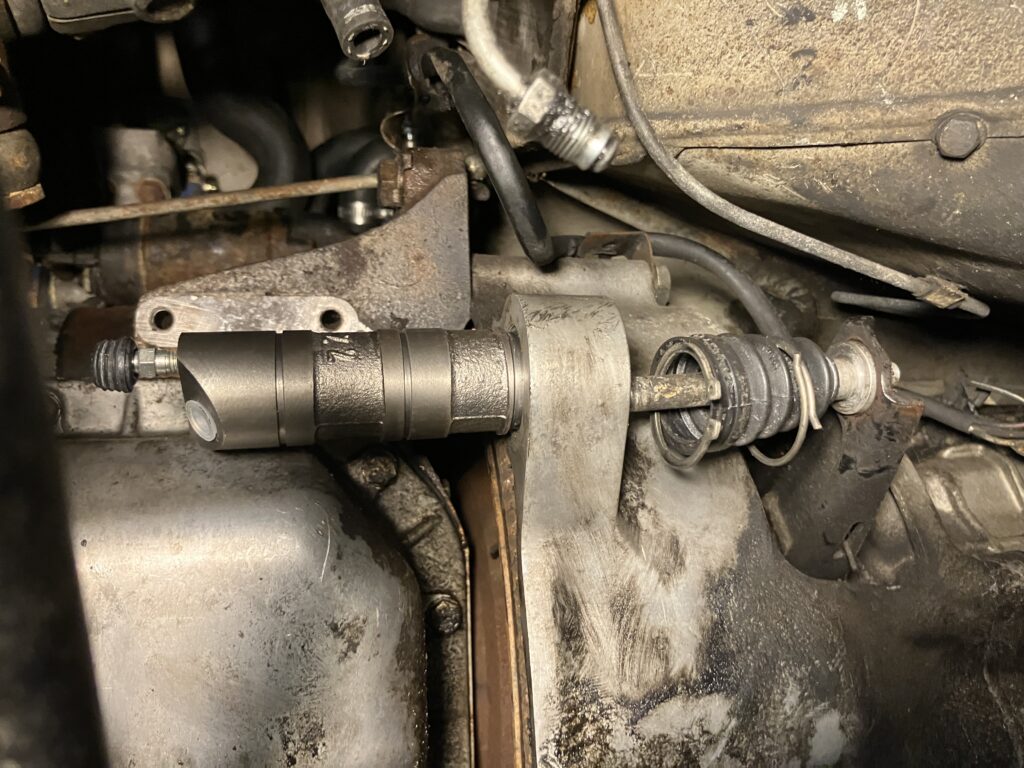
As they annoyingly say in repair manuals, assembly is the reverse of disassembly.
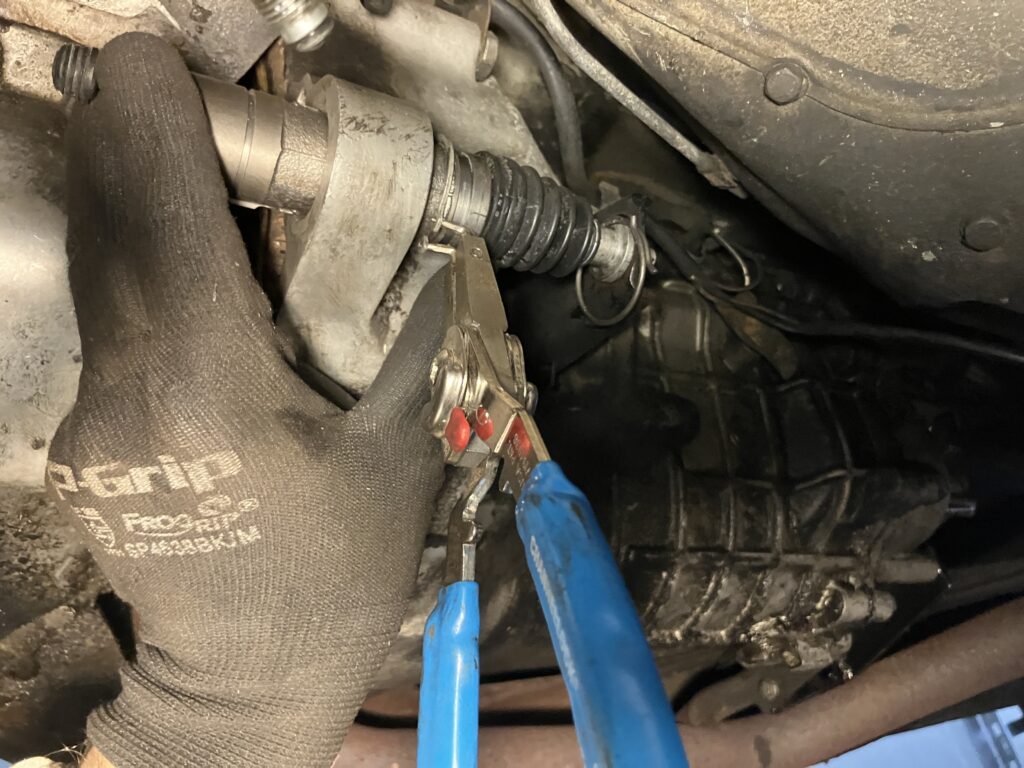
It’s a delicate dance.
When the rear of the cylinder is circlipped in place, you then slide the boot over the end, expand its spring clip so you can slide it into place, reinstall the half-moon flywheel cover, the little plate over the front of the slave, and the front circlip, then hook up the hydraulic line, and bleed it.
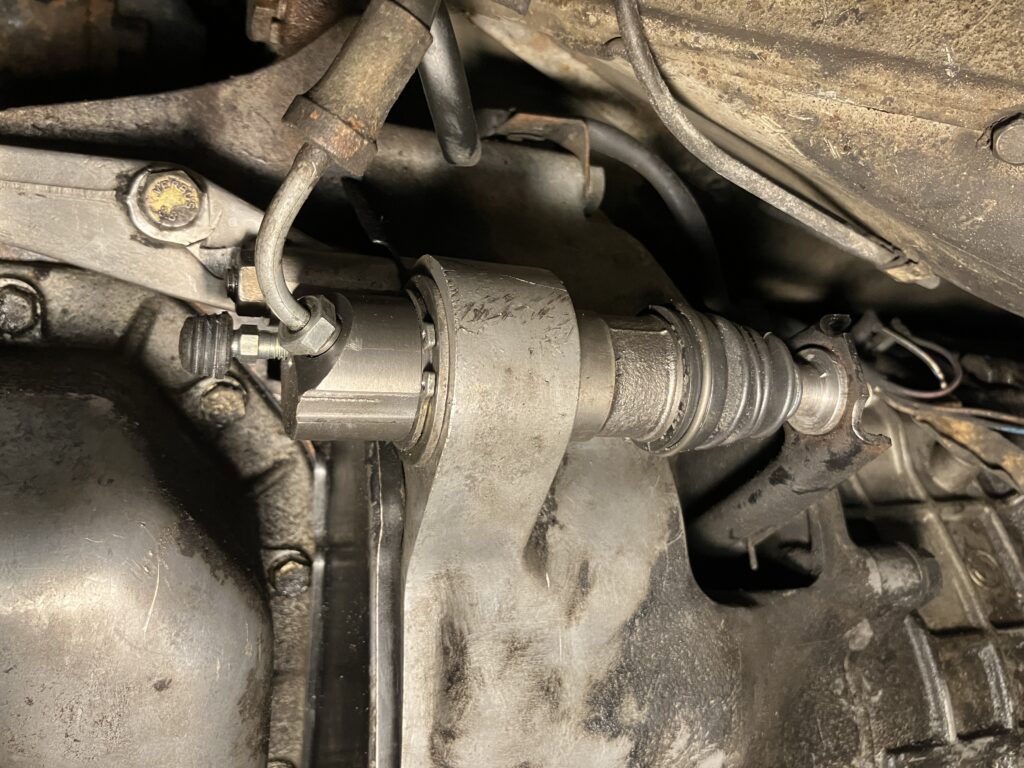
All buttoned up.
I began dealing with the muffler next. As I said, when I bought the car in 2014, it had a good-sized hole in it. At the time, I wrapped it in a piece of chimney pipe and held it in place with four big hose clamps. About five years ago I found an NOS factory muffler on eBay for short money, but hadn’t ever installed it. Clearly now was the time. In an odd bit of symmetry, I’d done a similar thing when I sold the Stricklands Kugel six years ago. In that situation, I unclamped the old muffler, carefully chiseled it off the resonator, slid the new one on, and clamped it in place. I assumed I could do the same thing on the Bavaria. Unfortunately, when I looked, I saw that the Bavaria’s muffler was welded to the resonator, and the weld was so close to the bracket holding up the exhaust that there was no way to affix an adapter or sleeve. Plus, on close examination, there was a small hole near the end of the resonator pipe. If this was a 2002, I’d just buy a new resonator, but it appears that, for the Bavaria, nothing is available, either original or aftermarket.
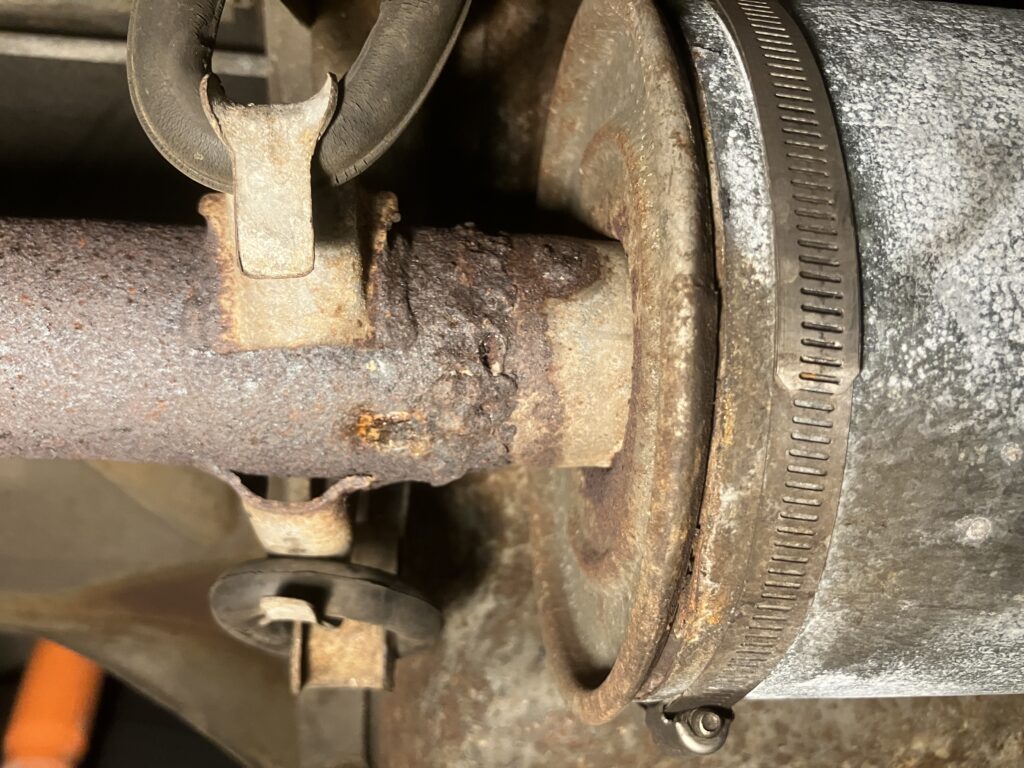
You see the problem.
I write about exhaust work a fair amount in my other column for Hagerty, and people often respond that I make things a lot harder than they need to be by trying to do everything myself when I should just take the car into some small exhaust shop on the other-side-of-the-tracks part of town where I can get a muffler welded on for a hundred bucks. I decided to take their advice. First I took the car to a chain muffler shop. They said that they no longer do any cutting and welding, only bolting-on of new parts. Then I went to a custom exhaust shop that I’ve had do some minor work over the years. With sadness in his voice, the guy told me that they’ve been bought, the parent shop still does that kind of work, but his shop no longer welds exhausts on cars this old. So I went to a one-man shop that I’ve used for some odds and ends like when a brake line burst in the Suburban and I didn’t have the time to fix it. The guy looked at my photos and said that what he’d need to do was chop off the section of pipe that has the hangers on it, split it in half to reuse the hangers, weld in a new section of pipe, weld the hangers onto it, and then weld the muffler onto that, and that it’d cost $280. So much for solving the problem by throwing a hundred bucks at it.
I decided to try it myself, thinking that if I cut the muffler off, I could measure the inside of the resonator end and see if I could buy a sleeve that fit inside both it and the muffler (yeah, I know, total kluge). So out came the Sawzall, during which I learned something important: Cutting through a weld takes WAAAAY longer than cutting through a section of pipe.

This took forever. The fat zip tie was so, once I cut through the pipe, the muffler wouldn’t swing back and hit the nose of the Lotus Elan that was right behind it.
Unfortunately, once the muffler was off, I could see that irregularities on the inside surface of the resonator made it impossible to do something like sleeving it.

Sadly, no sleeve for you.
As they say, sometimes you need to pay the man. The guy did a very nice job with the pipe resection, extension, hanger-welding, and muffler attachment.
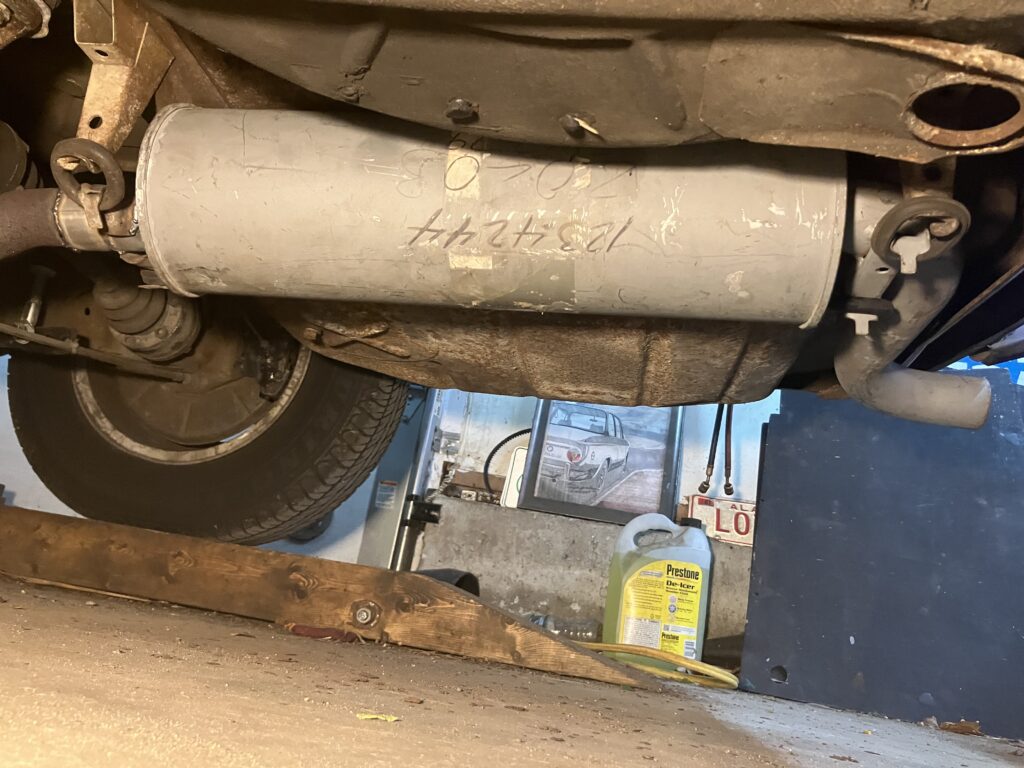
Chimney pipe and hose clamps be gone!

The original hangers welded onto a short section of pipe between the new muffler and the old tailpipe.
Next week, I attack the hood brackets and the even-throttle buffeting issue.
—Rob Siegel
____________________________________
Rob’s newest book, The Best of The Hack Mechanic, is available here on Amazon, as are his seven other books. Signed copies can be ordered directly from Rob here.
Tags: bavaria finding parts muffler





